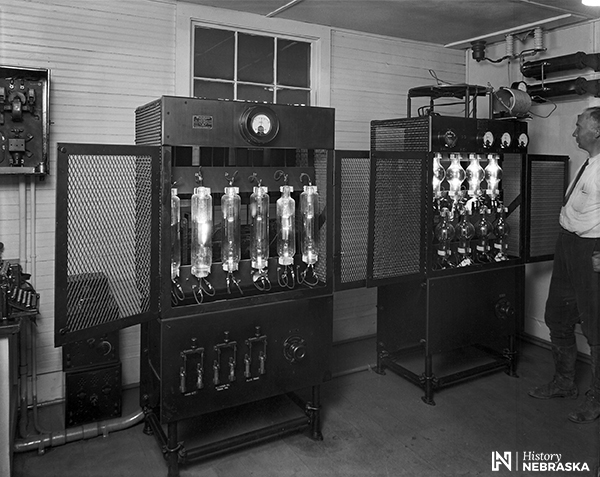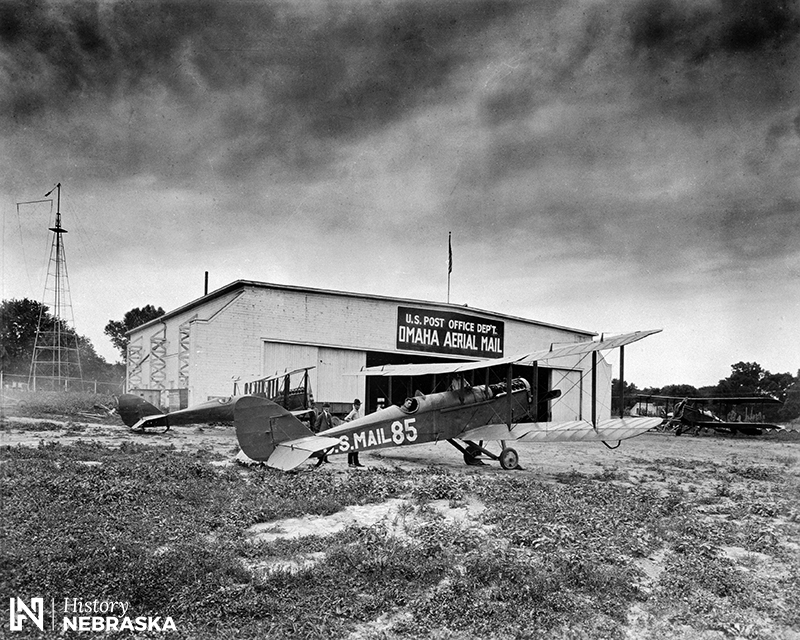
By Breanna Fanta, Editorial Assistant
As an emerging invention in the early 1920s, radios became popular as entertainment and as a means of communication. The potential use of radios in airplanes intrigued engineers and scientists, but they had concerns about the effects of distance, speed, and noise inference. As the US Post Office expanded its airmail operations, the needed to improve pilot safety became more urgent. Determined to solve this issue and break an international “radio phone” record, in 1922 the Omaha Airmail Field took up the challenge.
Why Omaha? According to official statements, “The Omaha field [was] the only radio ground station in the United States equipped for transmitting to airplanes.” Airfield staff began preliminary tests in November 1922. With knowledge of prior experimental radio usage in war aircraft, they began to devise a plan to test long-distance radio communication from planes. A year later, they finalized a full test.
The plan involved equipping an airmail plane with a radio receiving and transmitting set for a flight from Omaha to Cheyenne. A 1,000-watt radio transmitter was specially designed to send messages between ground control and the plane. Throughout the duration of the trip, reports would be frequently exchanged regarding weather, messages, and orders from the field, as though it were an actual airmail flight. The question was whether or not the messages would be successfully carried and audible.


On December 14, 1923, the day before the official test flight, final preliminary tests were done to ensure the safety and function of the plane and radio. The next day, a young pilot and his passenger departed from Omaha. The passenger, Eugene Sibley, was radio traffic supervisor of the airmail service. The pilot, Jack Knight, hoped to break his own 100-mile distance record for “radio phoning.” 
There were many unknowns during the early period of radio development. One of them was how an airplane’s high speed might affect radio reception. When the plane made its first stop in North Platte, NE, Knight and Sibley confirmed that messages had been clearly delivered over 250 miles, breaking Knight’s earlier record. They noted that during the three-hour trip to North Platte, messages had been received even while the plane was flying 100 mph.
The problem of sound interference had also been eliminated. Communication about the plane’s location, landing, departure, and conditions was effective between Omaha and the airplane. The success of the trip was credited to the willingness of Jack Knight and Eugene Sibley, efforts made by the men who installed the radio sets, the Western Division Superintendent, and the radio engineer.
As a result, the Westinghouse set and the transmitter used during the test were installed at the Omaha Airfield and later at other locations. With the discovery that messages could be carried from 300 to 500 miles during the day, and 1,000 miles at night, the 1923 flight demonstrated efficient radio communication over a long-distance flight. While it was not the first use of radio in airmail service planes, it helped pave the way to expanded use of the new technology.
Photos:
Top: Jack Knight, as pictured in an Omaha World Herald newspaper from December 27th, 1923, holding the apparatus that enabled communication to ground control.
Middle: (As appeared left to right) 1. One of Omaha’s Aerial Mail planes, similar to the one Knight operated. 2. Photographed is the US airmail transmitter equipment, like the ones used during Knight’s flight.
Bottom: Pictured, as shown in an Omaha World Herald featured articled from December 27th, 1923, is the equipment used in the plane’s cockpit. (Labeled in image): 1. Printed instructions that Knight used. 2. An apparatus that “the pilot [needed to learn] to tune properly as he [clipped] the air at a hundred-an-hour pace.” 3. An antenna reel (200 feet of copper wire with a five pound weight on the end that was reeled out and hung below the plane after reaching a “proper altitude.”)



